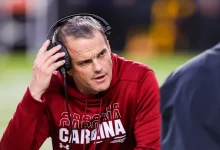Is adding a third cornerback to Ohio State’s 2026 recruiting class necessary for the Buckeyes’ future depth and flexibility at the position?

The question of whether Ohio State should prioritize adding a third cornerback to its 2026 recruiting class revolves around several critical factors, including current roster composition, future depth needs, positional versatility, recruiting strategy, and the evolving landscape of college football. As one of the premier programs in the nation, Ohio State’s recruiting approach must balance immediate team needs with long-term depth to maintain competitiveness at the highest level. This comprehensive analysis explores the importance of cornerback recruitment for the Buckeyes, evaluates the strategic implications of adding a third cornerback, considers the current roster and future projections, and examines how this decision fits into Ohio State’s broader recruiting philosophy.
The Significance of Cornerback in Ohio State’s Defense
Ohio State’s defensive identity has historically been built around aggressive, versatile, and talented defensive backs. The cornerback position, in particular, plays a vital role in the Buckeyes’ defensive schemes, which often emphasize man-to-man coverage, aggressive press techniques, and versatile dime packages. Effective cornerbacks are crucial for shutting down elite receivers, disrupting passing attacks, and enabling the defense to be flexible against varied offensive schemes.
Over the years, Ohio State has produced numerous NFL-caliber cornerbacks such as Denzel Ward, Marshon Lattimore, Eli Apple, and Jeff Okudah, emphasizing the importance of recruiting and developing top-tier talent at this position. The cornerback’s impact extends beyond individual plays; their presence influences the overall defensive scheme, providing the coaching staff with the flexibility to deploy multiple coverages and blitz packages. Therefore, recruiting depth and talent at cornerback are strategic priorities for Ohio State.
Current Roster and Future Depth at Cornerback
To evaluate whether adding a third cornerback in the 2026 class is necessary, it’s essential to analyze Ohio State’s current roster, incoming recruits, and projected future needs.
Existing Roster Composition
As of now, Ohio State’s roster includes several talented cornerbacks, with some expected to be key contributors in the 2024 and 2025 seasons. Players like Denzel Burke, Jordan Hancock, and Davison Igbinosun are expected to form the core of the secondary. However, the roster also features younger players and depth options that will need to develop to sustain elite performance.
In terms of scholarship numbers, Ohio State typically carries around 85 to 90 players on scholarship, with a significant focus on recruiting talented players at critical positions like cornerback. Given that cornerbacks often face high attrition due to transfers, injuries, and the natural turnover in college football, maintaining adequate depth is vital.
Incoming 2024 and 2025 Recruits
The 2024 recruiting class is expected to bring in talented cornerbacks, which will help bolster depth. However, the 2026 class is still several years away, and recruiting projections often fluctuate based on the talent pool, coaching staff evaluations, and team needs. The question is whether Ohio State anticipates losing key corners after 2025 or whether the current trajectory suggests the need for additional talent in 2026.
Future Needs and Attrition
College football is characterized by high turnover, and the secondary is particularly vulnerable due to the physical and mental demands of the position. Transfers, injuries, and players leaving early for the NFL can significantly impact depth. Ohio State’s recent history indicates a willingness to adapt and recruit depth at skill positions, including cornerback, to remain competitive.
Given the typical attrition rates and the importance of having reliable options, adding a third cornerback in 2026 could be a strategic move to ensure the team remains resilient and prepared for both immediate and future challenges.
Strategic Considerations for Adding a Third Cornerback
The decision to prioritize a third cornerback in the 2026 class should consider several strategic factors:
1. Depth and Flexibility
Having at least three to four reliable cornerbacks is essential for a defense that frequently employs multiple coverages and blitz packages. A third cornerback provides depth to cover injuries and disciplinary issues, and also allows for more creative defensive schemes, such as nickel and dime packages, which are increasingly important in modern college football.
2. Development of Young Talent
Recruiting multiple corners early allows the coaching staff to develop younger players without immediate pressure to perform. This ensures a pipeline of talent that can step into starting roles as seniors graduate or leave for the NFL.
3. Recruiting Pipeline and Competition
Securing a third cornerback in 2026 can help Ohio State establish a competitive recruiting environment, encouraging other prospects to consider Ohio State as a destination for development and playing time. It also sends a message to current recruits that the program values depth and long-term planning.
4. Positional Versatility
Some cornerbacks possess the ability to play safety or nickelback, providing additional flexibility. Recruiting a versatile athlete in 2026 could give Ohio State more options to adjust to opponent schemes and injuries.
The Evolving College Football Landscape and Its Impact
College football has evolved with the proliferation of spread offenses, RPOs, and the increased importance of pass defense. Teams often deploy multiple defensive backs to counter these offensive strategies, making a deep, talented secondary more critical than ever.
The transfer portal also impacts recruiting strategies. Teams can now add experienced players mid-season, mitigating some depth concerns but also making it essential to recruit high school prospects who can develop into long-term starters. Ohio State’s approach to recruiting a third cornerback should align with its philosophy of building a sustainable, adaptable defense.
Potential Risks of Not Adding a Third Cornerback
Choosing not to recruit an additional cornerback in 2026 could have several implications:
- Limited Depth: If injuries or transfers occur, Ohio State might face a shortage of reliable options, forcing them to play less talented or less experienced players, which can lead to defensive breakdowns.
- Reduced Flexibility: A smaller cornerback rotation limits the coaching staff’s ability to employ diverse schemes, making the defense more predictable and vulnerable.
- Recruiting Disadvantage: If other programs prioritize depth at cornerback and Ohio State does not, it could be seen as a positional weakness, affecting overall recruiting rankings.
- Impact on Team Performance: Defensive struggles caused by lack of depth can lead to more points conceded, affecting the team’s chances of winning championships.
The Case for Prioritizing a Third Cornerback
Given the importance of cornerback in Ohio State’s defensive identity and the unpredictable nature of college football attrition, it makes strategic sense to prioritize adding a third cornerback in the 2026 class. This move would:
- Reinforce the defensive backfield with high-quality talent.
- Provide a safety net against injuries and transfers.
- Allow for more creative and flexible defensive schemes.
- Help sustain Ohio State’s reputation as a defensive powerhouse.
- Support long-term team development and recruiting efforts.
While recruiting priorities are often influenced by the immediate needs of the team, a long-term perspective is crucial. Ohio State’s history of developing NFL-ready cornerbacks and its commitment to excellence suggest that investing in a third cornerback in 2026 aligns with its strategic objectives.
The coaching staff should conduct thorough evaluations of prospects in the 2026 class, emphasizing athleticism, versatility, and character. Building relationships early with top targets ensures Ohio State remains competitive in the national recruiting race.
In conclusion, the evidence indicates that Ohio State would benefit from prioritizing the addition of a third cornerback in the 2026 recruiting class. Doing so ensures the team maintains its competitive edge, provides depth and flexibility, and upholds the standard of excellence that the Buckeyes are known for. As college football continues to evolve, proactive recruiting in critical positions like cornerback will be essential for Ohio State’s sustained success at the highest level.









